Tracks & Dry Lots

How to ‘Get it Right for the Horse’
We would like to encourage the ethic where, instead of always trying to ‘get the horse right’, we focus on ‘getting it right for the horse!
Such a ‘mental shift’ would certainly benefit a lot of horses.
There is really absolutely nothing wrong with the horses rather significant improvements could be made to the way we keep them.
We encourage people to ‘think outside the square’ in the way that they set up their properties in order to manage what grass they have. If you have a setup that gives you options it is easy to keep horses calm and healthy.
Prevention is way better than cure!
There is nothing more soul destroying for a horse than to be confined to a small area where there is nothing, no choices of where to hang out, nothing to scratch on and no other equine to interact with.
For some people, because their property lends itself to the suggestions on this website, the cost will be minimal, but others, especially where the land is not free draining, may need to invest resources.
It is an investment in your horse’s health and wellbeing as well as your peace of mind and safety. In the long run you are likely to save a large amount of money which would otherwise be spent on various treatments and veterinary expenses.
The Dry Lot
A Dry Lot is a good sized living space that is totally Grass Free.
Dry Lots don’t have to be boring little squares. Make strips that incorporate choices for the horse.
Include options of trees or sheds for shade and shelter and very importantly, maximize movement. Of course you can also exercise a calm healthy horse by riding him, which you cannot do a Grass Affected or laminitic horse.
Think up ways of enriching your horse’s environment if he cannot be out in the paddock 24/7.
The following are examples of great Dry Lots...
Cathy Dee's Dry Lot is roomy enough for the horses to bounce about in. It is situated under large pine trees so the horses have shade and shelter and places to go to get away from each other. The upshot is that they love it in there!
"I made this in 2016 when Zephyr developed a sudden onset of mild laminitis. Fortunately I caught it very early and brought him home with the others to this area, which at that time I simply fenced off with tape and standards.
Realising what a great area it is - lending itself to a Dry Lot, I had it fenced with equi-rope and it has been invaluable through spring when they were in it full time and on into a summer which has presented itself with unusual bouts of rain!
I can bring them in to live in it until the grass dries off and they can go back out into the paddocks."
2023
I have now also created a track. This is a 300 metre track which has a loop around trees at either end. The horses love being on this and have a ball playing in their soft sawdust area.
Because we have hard stony ground which is free draining, I have been able to simply surface the track with a load of bark chips. This will break down and have to be redone every couple of years.
The Calm Healthy Horses Dry Lots & Tracks
The CalmHealthyHorses dry lots (above) are used temporarily to bring horses back from head flicking or laminitis. Once they are nomalised they go out onto the track. All the dry lots have shade and shelter. (Below)
How to make an Instant Dry Lot
We received this message from Tracy in the Waikato...
'Hi I rescued 2 miniature ponies just over 2 months ago. I have never owned a horse or pony before. They were left to fend for themselves really before I got them. I spend time with them everyday now and have got to build up trust with them. However I realised one was acting differently than normally and was worried as I had read so much on Laminitis. I was also feeding them a pellet feed (just half a cup each) and this would have been new to them as they weren't getting any extra feed when I took them. Sure enough a vet visit confirmed it to be early stages of it.
We have very lush grass so am worried when she goes on it again. Because I am new to this I am always doubting myself and worry. What else can I do? Should I plant different grass in a area for them especially. She also has mud fever. Should I try to design a little area with bark chip or sand to avoid mud? Also how much hay should a miniature eat per day? Any other help or advice would be greatly appreciated'.
Tracy sent photos of her grass which in our experience is far too lush for little mini’s so we suggested to Tracy that she procure a small mesh hay-saver so the ponies never run out of hay but don’t waste any and also to find some old carpet (from the carpet stores) and lay it down. Voilaaa!! Instant Dry Lot and instant results:
“Oh I am so pleased I got on to her so quickly. Maybe it was the start but i got it in time? Today she is great. And eating is fine. Much better than Monday the day it all started she was very grumpy, sore legs (wouldn't let me touch), head shaking, etc. But haven't seen any of that from yesterday afternoon. But will watch her closely
Oh and they took to the small mesh hay net straight away...so glad i got that and I can keep it topped up”.
Tracy will have to keep the ponies in their ‘Dry Lot” most of spring. Her supportive husband had already built them a little paddock shelter. Sure the carpet will eventually start to disintegrate and have to go to the tip but in the meantime Tracy can keep them off the dangerous spring grass and not have to worry about them getting laminitis!
(The www.paddocksafe.co.nz website offers more permanent options).
PICS: The ponies happy in their 'Instant dry lot' ...




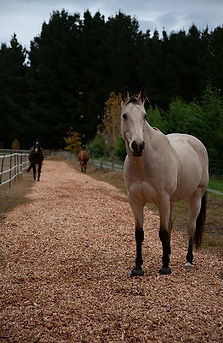


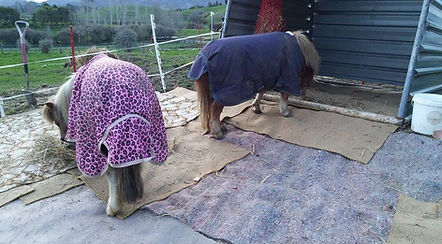
Keeping a Dry Lot or Track 100% Grass Free
For people who have horses/ponies or donkeys prone to or recovering from laminitis it is imperative that their living area is and stays 100% GRASS FREE!
This can be easier said than done in NZ, UK and many parts of Australia. Especially where rain events are occurring on a regular basis.
Anywhere you have fed out the hay you will see the green appearing from the seeds that are germinating, not to mention the grass and weeds that tend to sprout up along fence-lines.
It is a mistake to think that 'a little bit' won’t matter but you would be surprised, it really does matter for individuals whose metabolism is on the brink of a relapse.
The photos show how meticulous we are at CHH – we have learned by experience to be diligent from our collection of ex head-shakers and ex- laminitic horses & ponies.
Do what you need to do to prevent ANY nibbling on green shoots that are poking their nose out of the ground, and since doing gymnastic moves to get at grass under or through fences can really get in the way of the recovery process pay attention to those areas too.
Thoroughly covering up the area with sand or sawdust is ideal, make sure your surface extends at least half a metre on the other side of the fence. Use old carpet (very easily cut shapes/strips to suit with a box-cutter), mulch, pine needles – whatever you can lay your hands on to cover up any green.
You can spread salt on green patches in small areas like yards but this generally isn’t a viable option on larger areas. To be effective it needs to be quite thick, it will look like it has been snowing.
Fences need to be safe, secure and impenetrable like Fort Knox! Escaping out onto any kind of green grass could be catastrophic for a laminitis prone individual, it could mean the ‘end’!
It is money well spent to make somewhere that will be suitable now and for the future. Think long term as we have Autumn coming up soon in Southern Hemisphere and Spring in the Northern. Both are times of trouble for susceptible equines.
Avoid netting for fences (unless it is the purpose made Horse Mesh with gaps too small for any size hoof to go through).
Sheep or deer netting fences are just ‘vet bills waiting to happen’ as is any kind of wire unless it is plastic coated whereby it does not cut/slice.
Using high tensile wire is like fencing with knives and such fences have completely wrecked the legs of many horses here in NZ. Sometimes from such an innocent activity as having a roll - without realising they are too close to the fence………….out-riggers offer some protection but are not nearly as good as ensuring a horse-safe fence.
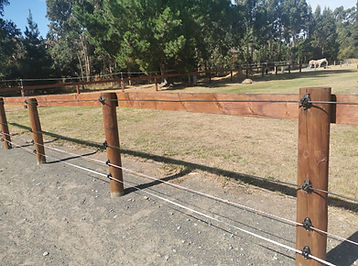
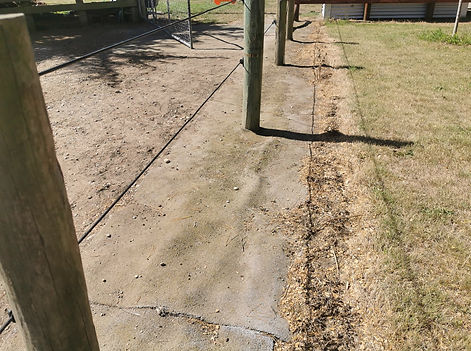



Pine Mulch makes a great surface for tracks and dry lots
Carpet is placed under the fence lines to prevent grass growing at the edges
Tracks can be beautiful havens...
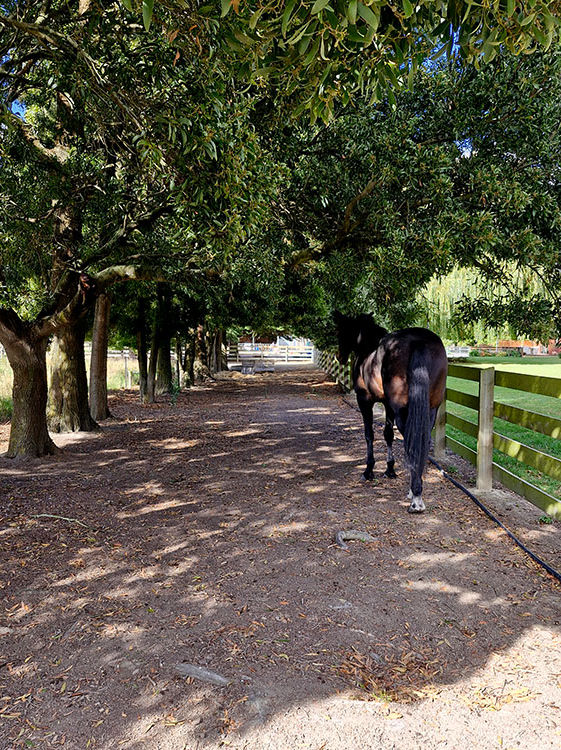
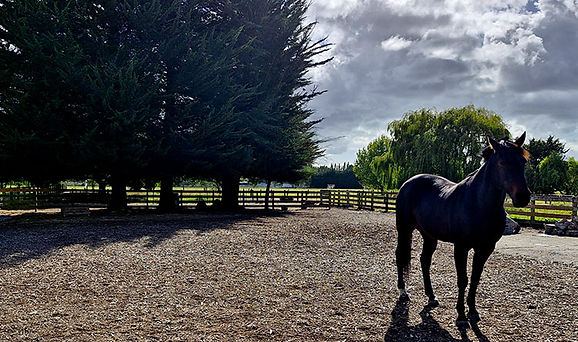
The Track System

The track at Mini HaHa Rescue Haven in North Canterbury is ideal. It is large enough to encourage movement and have multiple ponies living on it.
None of the ponies - all previously laminitic, have ever relapsed in over 7 years of living on this grass free dry environment.
Tracks are wonderful and ideal if you live on well drained country in a dry climate.
If your land is not free draining, tracks are not always the best option as they can quickly become slippery and muddy.
Here are some pros and cons:
UPSIDE:
· Gives the horses choices of shelter and shade
· You have more control over access to grass
· They are a good utilization of parts of your property that don’t grow grass very well anyway
· The area left in the middle can be left as one big area for growing hay/riding/letting the horses out for access to grass
· You only need one water trough and the inside fence can be a temporary one at first to see how it works out
· You can establish a variety of substrates – some sections of the track can be stony (round stones), and even a water crossing where possible – all very good for their hooves
· There are opportunities for enrichment – you can bring in a log or two for them to hop over, or a boulder or two to scratch on – they love this not just as a scratching place but also because it has created a ‘somewhere’ for them to hang out.
· It is a great way to keep horses in a herd and they can potentially all be exercised at once by keeping them moving around the track for a good workout. (either with you on a horse or on a push bike!)
DOWNSIDE:
· A Track is not a properly functioning track if there is any grass growing on it - rather it is just a very elongated paddock/field.
The more horses, the more it gets trashed and then compaction of the soil can interfere with drainage
· If you do want to keep the track grass-free it takes considerable effort as the grass keeps growing back - especially where you have a fed out the hay
· In wet areas, it is very expensive and not generally practical to make an all-weather extensive track.
Some people make a shorter area, so they always have somewhere dry for their horses to utilize over wet spells. Mud mats are increasingly popular and can work well in these situations.
If you are going to make a track:
· It is better not to be the same width all the way around – you need larger areas where, if the horses get spooked, they have somewhere to group and settle (bolt holes)
· Horses need somewhere soft and safe to have a lie-down and a roll, large enough they are not going to end up rolling into the fence
· Fences need to be ‘horse-friendly’ as the horses are confined between them in a relatively narrow space. Avoid sheep netting and high tensile wire!
· Incorporate options of shade and shelter
· You need several hay stations around the track or the horses end up hanging around in one spot. Place the water trough to maximize movement
Here is a great link for anyone thinking about putting in a track system
3 Ravens Natural Boarding in the UK...
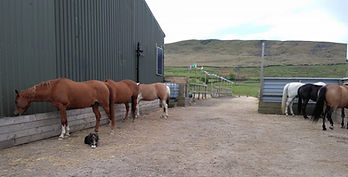
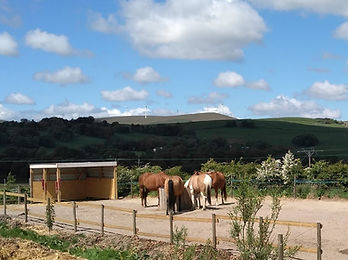

The Making of an All Weather
Dry Lot...
Becca Smith from Taranaki kindly photographed the process of building her all weather dry lot...

First they scraped off the top soil and laid geotextile fabric. This can be obtained from most Earthworks companies.

An A40 grade stone was spread and then fines and lastly the very fine sand on top.

The matting keeps the soil from mixing with the stones, making it more permanent in wet areas such as Taranaki.




Dry lots or Tracks are perfect for donkeys who also did not evolve to eat green grass!


Hay can be placed in slow feeder bags on the ground if the horses not shod...

You can also hang the bags on fence posts or up in trees...

HRH Zephyr uses a brush nailed to a tree, for grooming his moustache...
Most horses use it to scratch their butts...

All horses enjoy a dry space, with friends, shade and shelter. Dry lots and tracks should never be a boring place, with friends and things to do and places to go (choices), horses and ponies enjoy being on their dry lot...



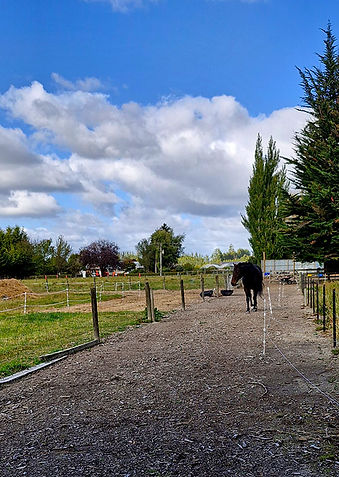

A track or dry lot should be an interesting place for the horse to live with options of shade and shelter available. Make sure the space is big enough for the horse to live on with other equine friends.
Rebecca Moody's stunning track is a beautiful example of this.
Some people are really thinking outside the square to create stunning living places for their cherished horses and it's great to see.
No horse should ever have to live in a boring square.
Start planting trees now, ideally you need trees that the horses are unlikely eat such as Douglas fir or Griselina littoralis, London Plane trees (pictured) etc
Tree shade provides the best shade as trees draw in moisture cooling the air by 12 - 15 degrees. This is vital in the hot summers.
